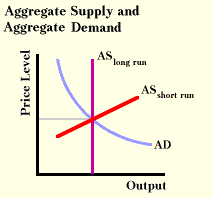Aggregated Markets Again
Economists usually combine the millions of markets in a modern economy into the four aggregated markets of goods and services, money balances, resources, and financial assets. They then ask two questions about each market: could it be a source of the instability that we observe as inflation and recession, and if the market is thrown out of equilibrium, how quickly will it readjust? We have now looked at each of these aggregated markets and arrived at this summary below.
Market |
Source of Disturbance |
Speed of Adjustment |
Goods and Services |
yes say the Keynesians |
moderate? |
Money Balances |
yes say the monetarists |
very fast |
Financial |
occasionally |
very fast |
Resource |
occasionally |
slow? |
The financial sector has been the source of shocks that disturb the rest of the economy. The collapse of a speculative bubble can lead to a recession, though only a few recessions are associated with collapsed bubbles. Perhaps a more threatening source of financial shocks has been failure of, or loss of confidence in, key financial institutions. Because of the way balance sheets of financial institutions are interlinked, this sort of failure, if not contained by a lender of last resort, has the potential of spreading to other institutions and to result in financial crisis, as happened in the Subprime Crisis of 2008. However, the more common role of the financial sector seems not to be as the source of shocks but as a transmitter. Because prices in financial markets adjust very quickly, they are the primary way that a disturbance in one part of the world economy affects other parts.
In recent years many economists have come to suspect disturbances in the resource market have at times been a source of economic disturbance. The oil embargo in the 1970s was followed by recession, and this episode brought a renewed interest in resource markets as a source of economic disturbance. When the availability of petroleum was suddenly reduced, price of oil rose, and the process of adjusting to this higher price may have cause disruptions visible as a fluctuation in the amount of output. However, the primary interest in resource markets comes from the belief that parts of it, primarily the labor market, seem to adjust slowly when prices must fall to restore equilibrium. If part of a system adjusts slowly, the entire system must adjust slowly.
There is disagreement among economists about how important the disturbances that originate in the market for money balances are relative to those that originate in the markets for goods and services. This disagreement took the form of a well-publicized debate between the monetarists and Keynesians in the 1960s and 1970s. Although today virtually all economists believe that monetary policy is very important, they do not agree on why. Some believe that it is important because it changes monetary balances, while others stress the influence that bank lending and bank credit have on the economy.
While most economists believe that the market for money balances adjusts quickly, many economists are not so sure that the same holds true for the markets for some goods and services. Many economists argue that there are adjustment problems in these markets as well as in the resource markets. If markets are not competitive, or if prices are controlled by the government, or if there are significant costs to changing prices, prices may not adjust rapidly. However, most economists believe that some of the "stickiness" of prices in goods and services reflects "stickiness" of prices in the labor market.
The above discussion suggests an addition to the aggregate-supply aggregate-demand model that was first illustrated in the chapter Money Matters. The aggregate-demand curve from that discussion is basically sound, and a vertical aggregate-supply curve makes sense as well, but only as a long-run curve. If there is price stickiness in either the resource market or in the market for goods and services, there should be a short-run aggregate-supply curve that slopes upward as in the graph below.

In this revised view of aggregate-supply and aggregate-demand, a sudden increase in spending of 10% will not immediately increase prices by 10%. Rather some of the extra spending will be absorbed by an increase in output. However, with the passage of time, markets will adjust, and the economy will eventually move to a position on the long-run aggregate-supply curve. (The short-run curve will slide up the long-run curve.) The long-run effect of the 10% increase in spending (assuming that the long-run aggregate-supply curve is fixed) will be a 10% increase in prices. The reader can work out the implications of a 10% decline in spending.
Finally, there are some economists who reject all of the discussion on this page because they believe that the fluctuations we observe are not caused by adjustment problems. We met this point of view in the discussion of real business cycles.
Copyright Robert Schenk